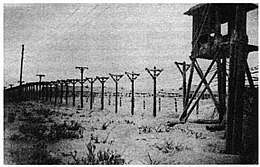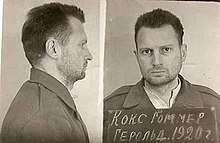Vorkutlag
The Vorkuta Corrective Labor Camp (Russian: Воркути́нский исправи́тельно-трудово́й ла́герь, tr. Vorkutínsky ispravítel'no-trudovóy láger'), commonly known as the Vorkuta Gulag or Vorkutlag (Воркутлаг), was a major GULAG labor camp of the Soviet Union located in Vorkuta from 1932 to 1962.

The Vorkuta Gulag was one of the largest camps in the GULAG system with 73,000 prisoners at its peak in 1951, containing Soviet and foreign prisoners including prisoners of war, dissidents, political prisoners, "enemies of the state" and common criminals who were used as forced labor in the coal mining works. The Vorkuta Gulag was the site of the Vorkuta uprising in July 1953.
History
The Vorkuta Gulag was established by Soviet authorities in 1932, on a site in the basin of the Pechora River, located within the Komi ASSR of the Russian SFSR (present-day Komi Republic, Russia), approximately 1,900 kilometres (1,200 mi) from Moscow and 160 kilometres (99 mi) above the Arctic Circle. The city of Vorkuta was established to support the camp, which was constructed to exploit the resources of the Pechora Coal Basin, the second largest coal basin in the Soviet Union. There were approximately 132 sub-camps in the Vorkuta Gulag system during the height of its use in the Soviet prison system. From 1939, Polish prisoners were held at Vorkuta following the Occupation of Poland until the German invasion of the Soviet Union in 1941. Vorkuta was then also used to hold German prisoners of war captured on the Eastern Front in World War II as well as criminals, Soviet citizens and those from Soviet-allied countries deemed to be dissidents and enemies of the state during the Soviet era.
The Vorkuta uprising occurred at the Vorkuta Gulag in July 1953, when inmates at various camps who were forced to work in the region's coal mines went on strike. The uprising, beginning as a mostly passive walkout, escalated into a strike involving 18,000 inmates across the Vorkuta camp system and lasted for approximately two weeks. On 1 August, the Vorkuta Gulag's camp chief Derevyanko ordered troops to fire at the strikers, resulting in the deaths of at least 53 workers, although estimates vary.
The Vorkuta camp was liquidated by order of the USSR Ministry of Internal Affairs and eventually closed in 1962, but large numbers of Soviet citizens who were former prisoners remained living in Vorkuta, originally due to their former status as enemies of the state, then as a result of their poor financial situation. Memorial, a Russian human rights organization that focuses on recording and publicising the human rights violations of the Soviet Union's totalitarianism,[1] estimates that of the 40,000 people collecting state pensions in the Vorkuta area, 32,000 are former gulag inmates or their descendants.[2]
American prisoners

A large number of American prisoners who were held by the Soviet Union passed through and/or were held at Vorkuta Gulag during most of the Cold War period. In particular, US military servicemen in Soviet custody were often detained at Vorkuta from the 1940s until as late as the 1980s. A significant proportion of American prisoners fell into Soviet hands towards the end of World War II, between the winter of 1944 and the spring and the summer of 1945, when the Soviet Red Army advanced further westward into Nazi German-occupied Poland and then Germany itself. Americans taken as prisoners of war by the Germans were transferred to large Soviet camps such as Vorkuta before repatriation. Many US servicemen were detained at Vorkuta during the Korean War from 1950 to 1955, mainly US Air Force pilots captured by North Korea and the People's Republic of China.
Other US servicemen detained at Vorkuta include those kidnapped by the Soviet military, perhaps with covert help from East German authorities, from the streets of East Berlin during the early part of the Cold War from 1945 up until the 1970s. On 6 September 1949, Homer Harold Cox, an American military policeman assigned to the US Army's 759th Military Police Service Battalion based in West Berlin, was arrested while off-duty in East Berlin within the Soviet occupation zone. Cox was subsequently imprisoned at various Soviet prison-camps and labour-camps, including at Vorkuta Mine No. Four and at Vorkuta Mine No. Seven, throughout his four-year period of captivity in the USSR. On 29 December 1953, Cox was finally repatriated back to the United States via West Berlin along with fellow American prisoner Leland Towers, who served in the US Merchant Marine. However, Cox died from pneumonia just less than one year later on 27 September 1954 in Lawton, Oklahoma.[3][4][5][6] John H. Noble, a 31-year-old American civilian from Detroit living in Germany, was imprisoned at Vorkuta during the early-1950s. Noble lived in Dresden, a city in the Soviet occupation zone, and was arrested on fake charges so local Soviet authorities could appropriate his family's camera manufacturing business. Noble was a leading participant in the Vorkuta uprising, but managed to survive the violent crackdown by Soviets. Noble was released in 1955 with several U.S. military captives thanks to the personal intervention of President Dwight D. Eisenhower, and wrote two books which described his experiences. Another American military serviceman detained by the USSR at Vorkuta around the same period of time was US Army private William Marchuk of Norristown, Pennsylvania, who was also kidnapped (either by the Soviet military or East German authorities) in East Berlin in 1949, and sent to the Soviet Union shortly afterwards.
Few American civilians and military personnel held by the Soviet Union at Vorkuta were ever repatriated back to the United States despite constant (but reduced and downplayed) pressure from the US government, which had actually been aware of the USSR's actions.[7]
Notable inmates
- Valentín González (1904-1983): Communist commander during the Spanish Civil War - Escaped.
- Dr Med. Horst Rocholl (1908-2004): Held at the camp 1942 -1953 Captured at Stalingrad.
- Der Nister (1884-1950): Influential Yiddish writer.
- Anton Kaindl: The commander of Nazi Germany's Sachsenhausen concentration camp between 1942 and 1945, who died at Vorkuta prison-camp in 1948.
- Jaan Kross (1920-2007): An Estonian writer.
- Jānis Mendriks (1907–1953): A Latvian Catholic priest.
- Nikolay Punin (1888–1953): A Russian art scholar, curator and writer.
- Günter Stempel (1908-1981): An East German politician and a member of the country's Liberal Democratic Party.
- Georgy Safarov (1891-1942): Bolshevik revolutionary, member of the Communist Party of the Soviet Union - Executed.
- Eric Pleasants (1913-1998): British soldier of the Waffen-SS British Free Corps.
- Revolt Pimenov: A Russian mathematician and a historian, also a Soviet dissident, and later, a post-Soviet politician.
- Mikhail Molostvov: A Russian dissident of the Soviet Union who later became a post-Soviet politician and a statesman.
- Eino Prykä (1919–1953): shot in Vorkuta uprising
- Shlomo Dykman (1917-1965): A Jewish-Polish (Later Israeli) translator and classical scholar.
- Cecilia Klein “Cilka” (1926-2004): Jewish survivor of Auschwitz- Birkenau. A novel based on her experience of the gulag was written by Heather Morris, titled “Cilka’s Journey.”
Notable guards
- Zoya Voskresenskaya, the chief of the Special Section of Vorkuta prison-camp, who served between 1955 and 1956.
In popular culture
- "Red Snow", the second segment of the twenty-first episode of the first season (1985–86) of the television series The Twilight Zone, features Vorkuta as the sanctuary of a vampire community.
- In the 2010 video game Call of Duty: Black Ops the player, an American named Alex Mason, is imprisoned at Vorkuta from 1961 to 1963, after being captured in Cuba during the Bay of Pigs invasion, and participates in a prisoner uprising along with his ally Viktor Reznov.[8]
- In 2012 the Black metal/Noise music band Gulaggh released the Concept album Vorkuta, which centers the Life and pain in the Gulag Vorkuta.[9]
- In 2015 Hawk Moth (Yöperhonen, WSOY 2015) Bly Finnish author Katja Kettu
References
- Memorial website(in Russian)
- Robert Conquest, Paul Hollander: Political violence: belief, behavior, and legitimation p.55, Palgrave Macmillan;(2008) ISBN 978-0-230-60646-3
- "THE GULAG STUDY". nationalalliance.org. Retrieved 17 February 2016.
- Handling and Processing of Prisoners in USSR, IR-255-56, NBG Team, 7051st Air INTSERON, 7050 Air INTSERGU (USAFE), 18 December 1956, Air Intelligence Reports 1947 -62 (AIR), Deputy Director for Collection and Dissemination (DDCD), Records of Headquarters U.S. Air Force (Air Staff), Record Group 341 (RG 341), National Archives at College Park, College Park, MD (NACP).
- Moscow #782 to State, December 30, 1953,611.6125/12-3053, Decimal, Central Files, RG 59, NACP. 31 The New York Times, January 22, 1954.
- The Stars and Stripes, September 29, 1954.
- Vorkuta Gulag- Time Magazine
- Williams, Raymond (12 January 2014). "Vorkuta for Victory: What Black Ops Got So Right". Venture Beat. Retrieved 8 June 2019.
- Vorkuta by GULAGGH